Perplexing could be the word. The Chevalier d’Eon could be said to have had a perplexing career. In France his name was a household word: of both masculine and feminine gender. Voltaire once famously described the Chevalier as “A nice problem for history.” …
Diplomat, writer, spy, and Freemason, a member of the elite Dragoons and one of the best swordsmen France, whose true gender was a source of speculation and provoked public bets in the late 18th century. Generally it was believed that d’Eon was born female, but he had started to dress as a man in his childhood, and changed back from “a bad boy into a good girl” when his secret was revealed decades later. After his death it turned out that he was a man who had dressed as a woman. D’Eon is often called the patron saint of transvestites.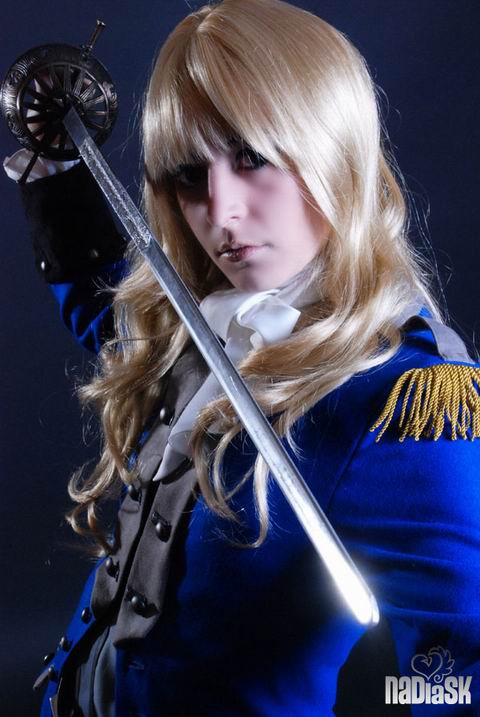
On May 21, 1810 , an urgent call went out for a physician from 26 New Milman street in London. Medemoiselle Genevieve d’Eon, the aged French heroine was dying. There was a time when the news would have produced a sensation, for her bizarre secret had once stirred all England and the Continent to debates and unseemly jests. Now, more than thirty years had elapsed since the formal court announcement that she was no man, but a woman, had ended her turbulent, troubled career as soldier, diplomat, troublemaker and spy. At eighty-one, France’s “second Joan of Arc” had outlived both notoriety and fame.
But there was to be one final sensation after all. When her body was being prepared for burial, it was discovered that Charlotte Génevieve Louisa Augusta Andrée Timothée Marie d’Eon de Beaumont, Chevaliere of the Royal and Militaery Order of Saint Louis, was no woman, but a man. So occurred one of history’s more startled double takes, inspired by a fiercely proud little man, now all but forgotten, who once held the uneasy peace of Europe in his hand. He helped reconcile Russia and France during that spirited period of diplomatic wife swapping known as the Reversal of Alliances; he was probably instrumental in prolonging the Seven Years War ald altering the terms of its settlement; he was involved, long before his sex became a matter of International speculation, in an extraordinary diplomatic scandal that threatened to expose Louis XV’s plot to invade England; a plot Louis had kept secret even from his own foreign minister.

"Aside from his status as a historical curio, and a failed attempt by Havelock Ellis to borrow his name to describe transvestism—Eonism, the Chevalier seems less celebrated than he might be. So it’s a pleasure to hear that theatre director Robert Lepage has created a new stage production, Eonnagatta, based on the Chevalier’s colourful life: For a long time now, the actor and experimental theatre director Robert Lepage has been fascinated by the life of the Chevalier d’Eon, an 18th-century French soldier who had a flamboyant career as a diplomat and secret agent for Louis XV, and spent much of his adult life dressed as a woman. Officially, the Chevalier’s skirts were worn as a professional disguise: his exceptionally fine features allowed him to pass easily for a woman, and thus move around undetected as a spy. But the Chevalier didn’t just do it for the job. He was a genuine cross-dresser, an 18th-century transvestite."
Many details of his story are hidden in contradictions, but he general outline can be established. He had qualities the French court admired. So handsome that he drove the ladies to distraction, but he was somehow not distracted by them in return. A slight effeminacy in his manner was offset by the reputation he quickly established as one of the best swordsmen in all France. He had a good, if not great, family name, a law degree, a familiarity with the classics, a ready wit and a flaming sense of honor. He became known as a brilliant conversationalist and essayist, which helped him eventually win the attention of Prince de Conti, who recommended him to the king.
Louis XV was just beginning to involve himself in an elaborate tangle known as “Le Secret de Roi” through which he intended to increase his influence in French foreign affairs whether his strong willed mistress, Madame de Pompadour, liked it or not. Conti would direct “Le Secret” ; its agents would spy on Louis’s own diplomats and undertake projects that might on occasion run counter to his government’s official policy. For work requiring such delicacy and dedication, De Conti told the king, D’Eon would be the ideal choice….
Louis XV’s plan to expel all homosexuals collapsed because his nephew and successor , Phillipe, Duke of Orleans, lived a transvestite and homosexual life. The most notorious transvestite of his time, Chevalier D’eon de Beaumont, was a good friend of the playwright Beaumarchais (1732-99 ). In addition, the court composer Jean-Baptiste Lilly (1632-87 ) who collaborated with Moliere on several court entertainments, was a member of the Sacred Fraternity of Glorious Pederasts… And rthe playwright Denis Diderot explored the details of forced celibacy and female sexual variance in his novel “La Religieuse” ( 1760 ). ” ( Paul Kuritz )
…E’on was swiftly initiated into “Le Secret” and whisked off to Russia on his first assignment. The mission was a success; Empress Elisabeth abandoned a British agreement and in 1756, allied herself with France and Austria in the Seven Years War. By now D’eon was a favorite in Elizabeth’s court and at Louis’s. After three successful years in the French embassy in St. Petersburg, was granted a life pension, was promoted to captain of the dragoons, and went on active duty receiving a citation for courage.
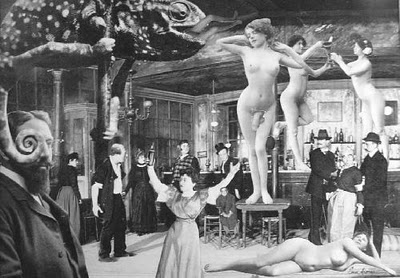 " />
" />Mademoiselle Alba dans le role de Chevalier D'Eon
Unfortunately, France’s fortunes in the war had gone from bad to worse; it was time to quit fighting and talk peace, which offered a new opportunity of advancement, which resulted in his appointment as first secretary to the ambassador, the Duc de Nivernais. This went well; Nivernais plied the British undersecretary with wine and women, and D’Eon made off with his portfolio, copied the secret British bargaining position on Cuba, and rushed it off to Versailles.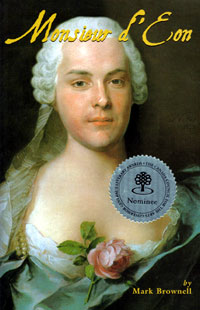
D’eon was approaching the pinnacle of his dazzling rise. The king promised him money, and most intoxicating of all, gave him the Cross of the Order of St. Louis. D’eon was now a chevalier. He was dispatched to London and was to serve publicly as France’s representative to the English court; in addition to working privately to further the latest secret plan hatched by Louis XV.
For no sooner had the Peace of Paris been signed than the French king, without informing either his ministers or mistress, began to plot the conquest of England to regain the glory and empire so newly lost. D’eon’s secret orders were to undertake a series of espionage assignments to help pave the way for the invasion and to keep an eye on the new ambassador. He would report to the Comte de Broglie who had succeeded De Comti as director of “Le Secret” .
D’eon was a natural in the brilliant social swirl of London, a polished an extravagant host and frequent guest of George III and Queen Charlotte. But back home the enemeies of Louis’s espionage networ, which by now was not as secret as the king believed, began plotting D’Eon’s downfall. The foreign office accused him of spending too freely.
“Since he came from the Burgundy region of France, wine was a passion and a means of influence. He lavishly entertained with bottles he’d imported to England at the French government’s expense. One invoice indicates that d’Éon received 2,800 bottles in one shipment. Then he had the audacity to ask his superiors to advance him money as his personal finances were also a mess. D’Éon was quickly becoming more of a liability than an asset.”
The complaints worked, and under the pressure of the pushy, Pompadour, Louis XV abandoned his agent to the enemy. The Comte de Guerchy, an old enemy of D’Eons, was sent to London as ambassador and ordered him to return to Paris and await instructions without going to court. But D’eon refused to turn over correspondence, would not present his letter of recall to King George, and would not leave the country.
What followed was diplomatic fantasy. Guerchy had plans to kidnap his troublesome predecessor and return him to France. D’eon fortified his apartment, mined the ground floor and staircase,assembled bodyguards and collected an arsenal of pistols and guns. London watched in amazement. The situation grew worse; D’eon was formally disowned by the king and branded a traitor. George III proclaimed him an outlaw. Meanwhile, D’eon continued, or so he claimed ever afterward, to receive secret letters from Louis urging him to guard his papers with his life. In return, D’eon threatened to “embrace the cause of the King of England” and reveal all if his persecution continued.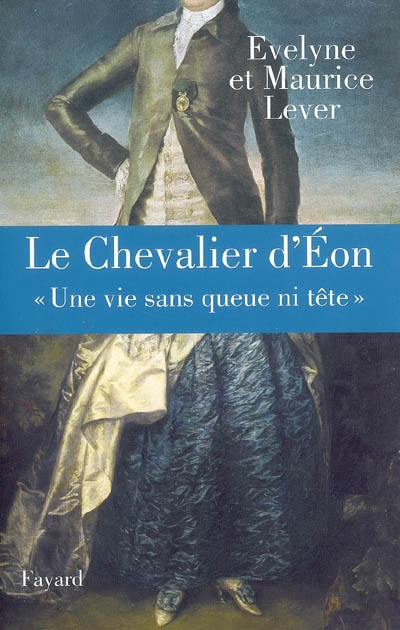
D’eon accused Geurchy of trying to poison him which led the ambassador to sue for libel and D’eon countered with formal charges to a grand jury, which indicted the ambassador on charges of conspiracy against his countryman’s life. It was a situation without precedent. Such intrigues usually die out within months; this one rocked along from crisis to crisis for more than ten years. Guerchy went home to die, perhaps of sheer irritation and his successor tried in vain to wrest the secret papers from D’eon. Louis claimed D’eon was mad, but prudently sent him funds from time to time to assure his silence.
The stalemate might have lasted forever had Louis not died and put an end to the whole rickety structure of “Le Secret”. Now began Act III, where D’eon a branded traitor, was about to become of all things, a celebrated heroine. Rumors that he was actually a woman were not new. A Russian exile, Princess Dashkoff told friends in London that D’eon had appeared as a woman in Empress Elizabeth’s court, a story which soon became the scandal of he day.
London gamblers bet fantastic sums on the chevalier’s sex and D’eon claimed that wagerers had tried to kidnap him.Britain’s finest minds did not know what to make of him. In the words of Horace Walpole, “she” was a “noisy and vulgar individual whose hands and arms… are fitter to carry a chair than a fan”. James Boswell concluded that “she seemed to me to be a man in woman’s clothes”.Louis XVI’s representatives found this quite interesting in terms of settling the old fued. Certainly the “reparations” D’eon sought in return for surrendering his moldering secret papers would be unnecessary: He could not be restored to his former office, for example, if he were a woman.

" In order to save the French government embarrassment, d’Éon had to justify his female to male transvestism. His back story explained that his mother was a noble and his father had squandered her dowry, sending the family into debt. Her family would give them a large inheritance if she had a son. D’Éon was born a girl but was immediately dressed and treated as a boy to fulfill this requirement. In the creation of this mythical background, d’Éon intimated that the cross-dressing position in Empress Elizabeth’s court was fabricated. An agreement was reached between d’Éon and King Louis XVI allowing d’Éon to retain the military honors he’d achieved as a man. The King insisted, however, that d’Éon dress and act like a woman. He acquiesced and in 1779 she became the Chevalière d’Éon and returned to her homeland, spending the next six years living with her mom."
The sharpest tongued Frenchman of his day, Pierre Augustin Caron de Beaumarchais, was sent to London to negotiate an agreement. A comic opera interlude followed in which D’eon appeared to confess that the rumors were true and Beaumarchais succumbed, or seemed to succumb to the D’eon charms. Whatever the facts, the famous playwright composed a convincing script for his sovereign. When the sex of the wonderful creature was considered, he wrote Louis, the heart was moved with sweet compassion.
Acrimoniously, an agreement was finally reached. Having been officially declared a female, D’eon headed for Versailles. The condition being D’eon had to give up all male attire except his uniform, which was to be kept purely as a souvenir, but she attempted to wear nothing but the uniform, much to the irritation of the king. At this point a delighted marie Antoinette announced she would outfit D’eon with her own funds. Once the wardrobe was ready, the gallant lady, the heroine was presented a court before a tremendous crowd. The excitement, the adulation, the constant attention, could only have been soothing: she was appreciated again at last.
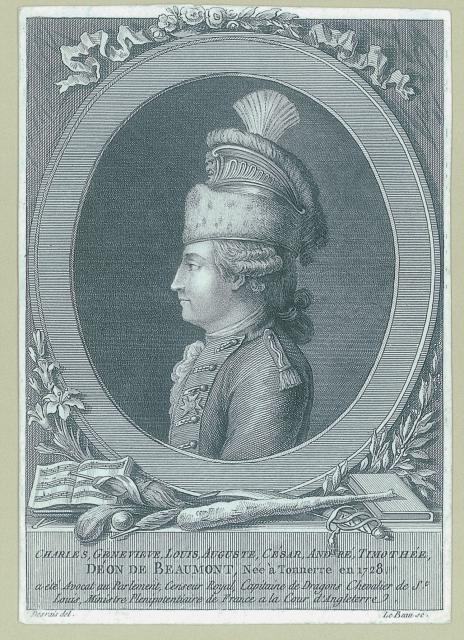
"Beaumarchais was as thoroughly taken in as any dupe in his own comedies. In d'Éon he 'saw a blushing spinster, a kind of Jeanne d'Arc of the eighteenth century, pining for the weapons and uniform of the martial sex, but yielding her secret, and forsaking her arms, in the interest of her King. On the other side the blushless captain of dragoons listened, with downcast eyes, to the sentimental compliments of Beaumarchais, and suffered himself, without a smile, to be compared to the Maid of Orleans,' says the Duc de Broglie. 'Our manners are obviously softened,' wrote Voltaire. 'D'Éon is a Pucelle d'Orléans who has not been burned.' To de Broglie, d'Éon described himself as 'the most unfortunate of unfortunate females!' D'Éon returned to France, where he found himself but a nine days' wonder. It was observed that this pucelle too obviously shaved; that in the matter of muscular development she was a little Hercules; that she ran upstairs taking four steps at a stride; that her hair, like that of Jeanne d'Arc, was coupé en rond, of a military shortness; and that she wore the shoes of men, with low heels, while she spoke like a grenadier! At first d'Éon had all the social advertisement which was now his one desire, but he became a nuisance, and, by his quarrels with Beaumarchais, a scandal."
During the next eight years, the second Joan of Arc became a living legend; portraits were bought of her and songs written in her praise. Visiting princes sought her out. Now the chevaliere began to embroider on the story herself. Yes, she had appeared in Elisabeth’s court as a woman, but, she confessed, because she was a woman!. She had only donned male attire at the request of her king and how faithfully she had served him. The nation rang with her praises.
The years passed, the cheers subsided and the reputation began to fade. She returned to England, in the hope of creatin another sensation. And create it she did. The chevaliere was lionized by British society and won praise by taking up fencing again. The Prince of Wales attended a match at which she is said to have defearted Saint-George, one of the great fencers of Europe. She stayed in England permanently now; the revolution brought an end to the pension she had received since the Beaumarché settlement. She remained in seclusion now, living out her years in near poverty on a small pension conferred by Queen Charlotte.

"The poor old boy was badly hurt at a fencing match in his sixty-eighth year, and henceforth lived retired from arms in the house of a Mrs. Cole, an object of charity. He might have risen to the highest places if discretion had been among his gifts, and his career proves the quantula sapientia of the French Government before the Revolution. In no other time or country could 'the King's Secret' have run a course far more incredible than even the story of the Chevalier d'Éon. "
Still, the question remains as to why he spent thirty-three years of his life as a woman? One theory suggested a scandal involving Queen Charlotte, which could be suppressed only if D’eon spent the rest of his life in petticoats. In the end the man who had failed so often in his search for fame gave the language a word to remember him by. Havelock Ellis seized upon the chevalier as ” the protagonist of transvestism” to describe a psychic anomaly. Ellis seemed to have the final say on a character who may survive longer in psychiatry than in history.
” ( Gary ) Kates argues that d’Eon’s gender transformation was in part a response to a failed political career as a spy and ambassador. But the book also draws on d’Eon’s never-published autobiographical writings and examines his extensive collection of radical feminist books to reveal the extraordinary theory of sexual differentiation that inspired his adventure into womanhood. In the end, d’Eon had come to believe that a person who lived as a man was doomed to a life of sin; the only hope for moral redemption was to live one’s life as much as possible as a woman. D’Eon wrote: “God created man and woman, the one for doing good, the other for doing bad. So long as a man is a man, the earth is his; so long as a woman is a woman, virtue is hers.”
Comment from a contemporary:
FROM EDMUND BURKE’S Annual Register (1781): “It must indeed be acknowledged that she is the most extraordinary person of the age. We have several times seen woman metamorphosed into men, and doing their duty in the war; but we have seen no one who has united so many military, political, and literary talents.”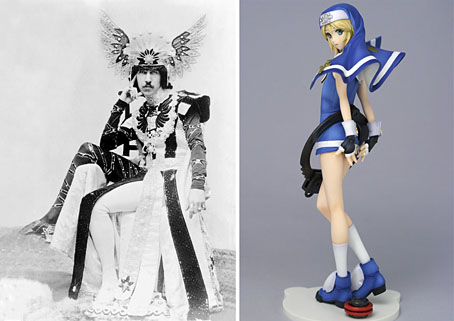
“But for all the farce, many commentators - including Mary Wollstonecraft - considered d’Eon to be one of the pioneers of the feminist movement, articulating views about the female perspective from a unique position. The Brotherton archive reveals how he built up a library of 6,000 volumes and 500 rare manuscripts including a collection of radical feminist books which explored the 18th-century Querelle des Femmes (quarrel about women). Gary Kates suggests that these inspired his views about sexual differentiation and his adventure into womanhood. “God created man and woman, the one for doing good, the other for doing bad,” d’Eon wrote. “So long as a man is a man, the earth is his; so long as a woman is a woman, virtue is hers.”
…Whatever the private motivations behind his extraordinary life, d’Eon’s 49 years as a man and 34 as a woman do not seem to have provided the one experience that someone who has enjoyed life on both sides of the gender divide might be expected to encounter. Documentary evidence suggests that Monsieur d’Eon may well have died a virgin. ( Ian Herbert )


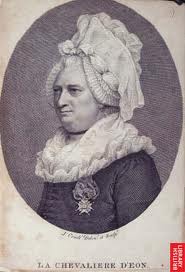
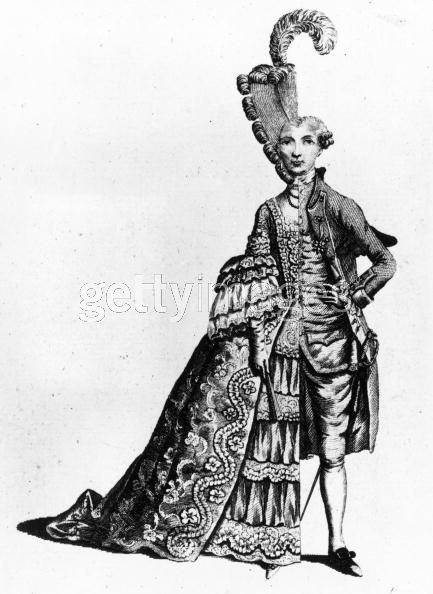



 COMMENTS
COMMENTS